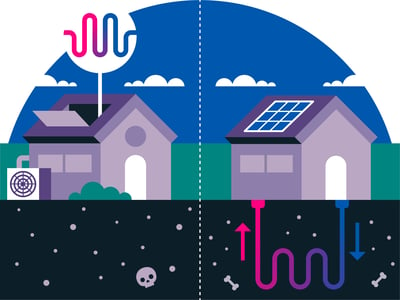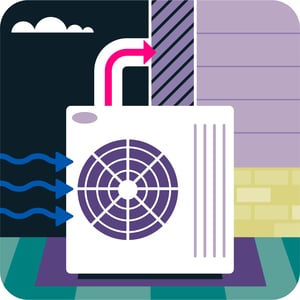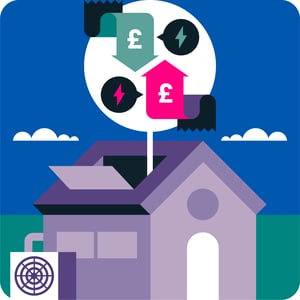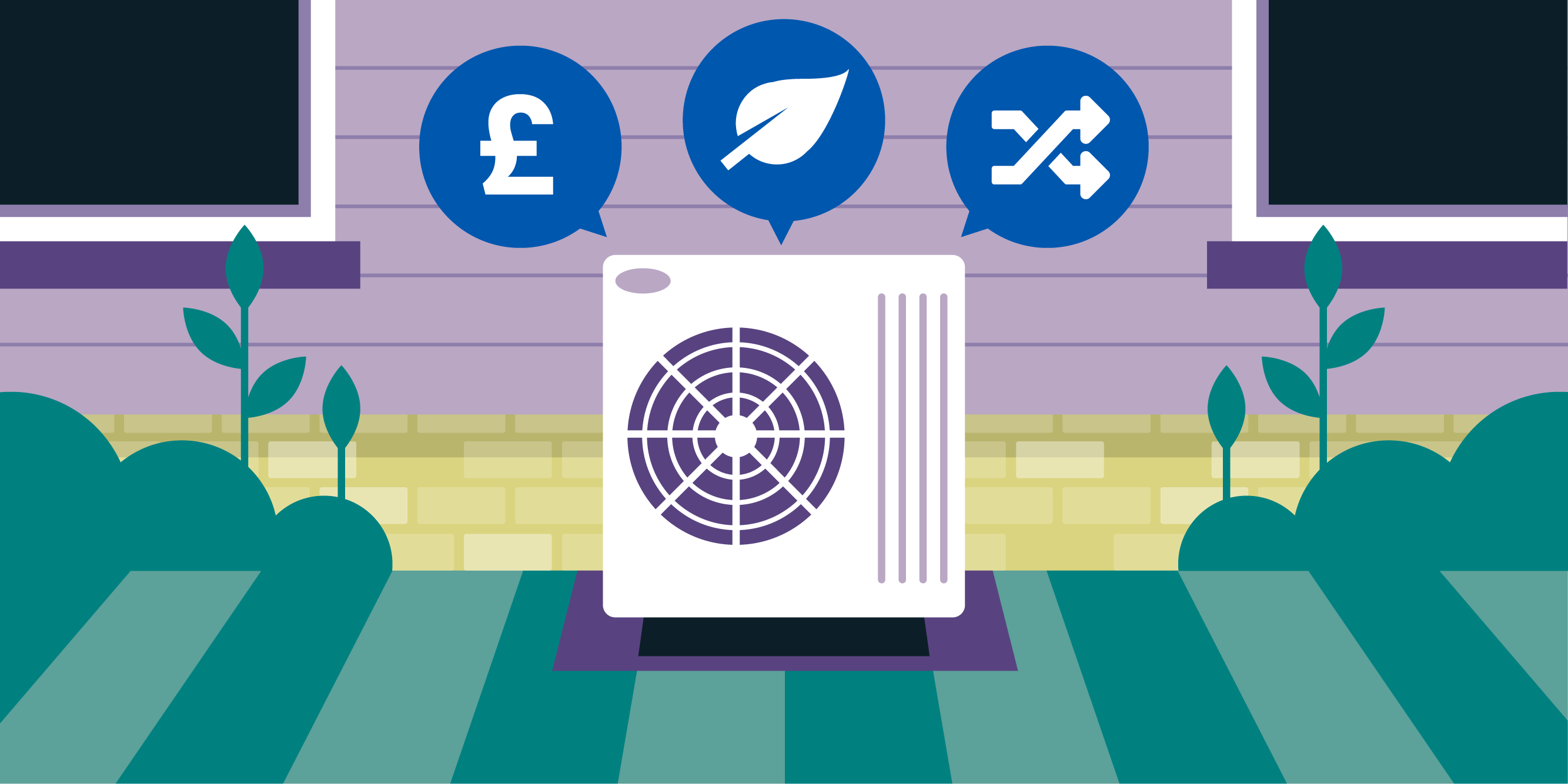Heat Pumps Explained: What Do You Need to Consider?
Heat pumps have been hailed as one of the key solutions to the challenge of creating greener UK homes. With big utility companies like Octopus investing considerably in the future of this clean technology, more and more people are now starting to consider how a heat pump could work for them.
Wasted energy makes up 30% of the average energy bill - do something about it! Get more from your smart meter with Loop.
However, whilst they can help cut your energy bill and carbon footprint, some households are much better candidates for heat pumps than others. They’re not a magic solution for everyone.
If you’re exploring heat pumps for the first time and are starting to consider whether they could work for your home, we’ve got the answers.
Types of heat pumps
There are two main types of heat pumps - air source and ground source. As the names suggest, air-source heat pumps (ASHP) work by absorbing heat from the outside air - using a large fan, and ground source heat pumps (GSHP) extract heat from the ground - using water-filled pipes buried underground.

Air source heat pumps are generally more common as they’re less intrusive to install, take up less space and are less expensive. Both are sustainable ways of heating your home.
Top considerations
Before you install an air source heat pump, there are 5 main things to consider:
- Placement. An air-source heat pump needs good airflow, so it needs to be placed in an area that has plenty of space. It can be mounted either on an external wall or on the ground, and the surrounding area should be clear from objects.
- Timing. When to replace your heating system is a key question - replacing fully functioning gas or oil central heating is an expensive option but equally if you wait until your boiler needs replacing it will inevitably break in the middle of winter and you’ll need a quick fix. So a planned replacement over the warmer months is a more sensible option, factoring in the normal service life of a gas or oil boiler and any large maintenance bills that are on the horizon. Replacing electric heating is a more invasive process, with pipework, radiators and/or underfloor heating to install. For that reason, it’s most often done as part of a larger renovation project.
- Insulation. An air-source heat pump has a lower output temperature than a traditional boiler, which is why it’s essential to ensure your home is well insulated before the installation. Otherwise, your new heat pump will have to work harder - and use more energy - to maintain a comfortable temperature or your house will just be colder.
- Noise. Air source heat pumps make some noise whilst operating - approximately between 40-60 decibels from one meter away. This is due to the fan and compressor when they’re in motion, so placing outside bedroom windows can cause some disturbance.
- Efficiency. Whilst air source heat pumps can operate at temperatures up to -20°C, they start to lose efficiency below 0°C. To keep things toasty, if you live in a colder area you may need to either install better insulation or have an additional heat source - both of which can add extra costs to the installation.
Potential problems
Although you can use radiators with an air source heat pump, the most efficient option is to use them in combination with underfloor heating. This is because with the large surface area you get the same heating capacity despite the lower output temperatures involved.
However, if you do use radiators it’s important to make sure they’re an appropriate size for your home and your household’s heating requirements. If they’re too small, they won’t be able to supply the level of heat your home requires. Many UK homes have surplus radiator capacity though so it’s not a given that you’ll have to install additional radiators.
Top tip: Want to test if your radiators are the right size for a heat pump? Run your current central heating on full blast with the thermostat turned right up. If your house gets too warm, your radiators are likely to be big enough for a heat pump. Just remember to turn it off again!
The way heat pumps work - by producing heat continually at a lower temperature - also makes it essential that your home is well insulated before installing a heat pump. A draft-proofed and well-insulated home helps retain the heat produced.

As heat pumps work at lower temperatures, you need to ensure you can move the necessary volume of water through the heating system, so the diameter of your pipework is important. This can cause some issues if your home is fitted with microbore pipework, popular from the 1970s onwards.
Running costs
There are lots of factors that influence the running costs of an air source heat pump, not only the make and model of the heat pump itself but also how the system has been designed for your household and the grants available for you. It’s impossible to say whether you save money but two main factors are:
- The Coefficient of Performance (CoP). This is the measurement of a heat pump's efficiency, comparing the input and output of power. The higher the value, the more efficient the heat pump system is. As a guideline, an average heat pump has a CoP between 2.5 and 4.5. If a heat pump has a CoP of 4, it means for every kilowatt of electricity used, 4 kW of heat is created.
- The indoor and outdoor temperature. The difference in temperature inside and outside your home will determine how much work your heat pump will need to do to maintain the temperature. Heat pumps generally have an optimum output temperature of around 50 degrees Centigrade. If you need it to run warmer than this because your home is inadequately insulated or your radiators aren’t large enough, whilst it could maintain output temperatures of up to 65 degrees, this comes at the expense of efficiency and therefore increases running costs.
With energy prices rising it might make financial sense for your home to invest in an air source heat pump - especially if you can benefit from a grant too. It also might make financial sense if your current system is old and inefficient. As an indication of running costs, for a medium sized UK home with an annual heat requirement of 12,000 kWh, a heat pump with a CoP of 3 will use 4,000 kWh of electricity. At 28.3p per unit (price cap level, June 2022) that yields an annual cost of £1,132. How does that compare to your gas bill?
For the purposes of simplicity we haven’t included water heating in the example above, but if you were wanting your heat pump to also heat your water, there would be additional costs, particularly as you’ll need to heat it to higher than 50 degrees.
So whilst your gas usage will go down with a heat pump, your electricity usage will go up. That’s where solar panels can help to offset this additional usage. If you’re building a new home, then this combination is a great way to future-proof it - reducing your bills and your carbon footprint in the process.
Installation process
The first step on your heat pump journey starts with getting a survey from a certified heat pump installer. They’ll be able to determine the best size and position of heat pump for your home - considering factors like the fabric of your home, type of windows, rooms dimensions and heat loss.
Air source heat pumps don’t usually require planning permission as they’re considered to be a permitted development in England, Wales and Scotland. However, if your home is listed or in a protected area then you’ll need to apply.
Then, it’s time to compare quotes and see which one could increase your savings with a government grant - most UK homeowners are eligible for at least one.

The Boiler Upgrade Scheme is effective from April 2022 to April 2025, taking the place of the Domestic Renewable Heat Incentive (RHI). The scheme is part of a funding package to help reduce the carbon emissions of UK homes, where homeowners can access government funds of up to £5,000 for buying low-carbon heating systems like heat pumps.
It works by applicants receiving a voucher that needs to be redeemed on the installation within 3 months. To be eligible for the scheme you need to have an Energy Performance Certificate (EPC) without any outstanding insulation recommendations.
It’s also worth remembering that VAT on clean energy technologies (including heat pumps and solar panels) has been cut from 5% to 0% until March 2027.
Is a heat pump right for you?
Ultimately, if your home is well-insulated with underfloor heating and you can afford the costs of early adoption, then heat pumps are a good investment.
However, if you’re looking to make one big change that will help offset your rising energy bill and cut the carbon footprint of your home, then installing a heat pump might not be right for you at the moment.
Instead, you might want to consider solar. Costing less to install and with a shorter payback time - 30% shorter since the price cap increase - you’ll see the benefits to your bill immediately. Plus, it’s a great first step towards creating a net-zero home and allows for other measures, like heat pumps, to be added in the future.
How would a heat pump cut your household’s carbon footprint? Try Loop’s free carbon calculator to find out. Then, see which other green measures could take your home to net-zero!
• • •
Cut Your Energy Bill With Loop
Loop is a FREE energy-saving app that links to your smart meter, analyses your energy use and shows you easy ways to save. On average, Loop users cut their energy use by 15%! How much could you save?








